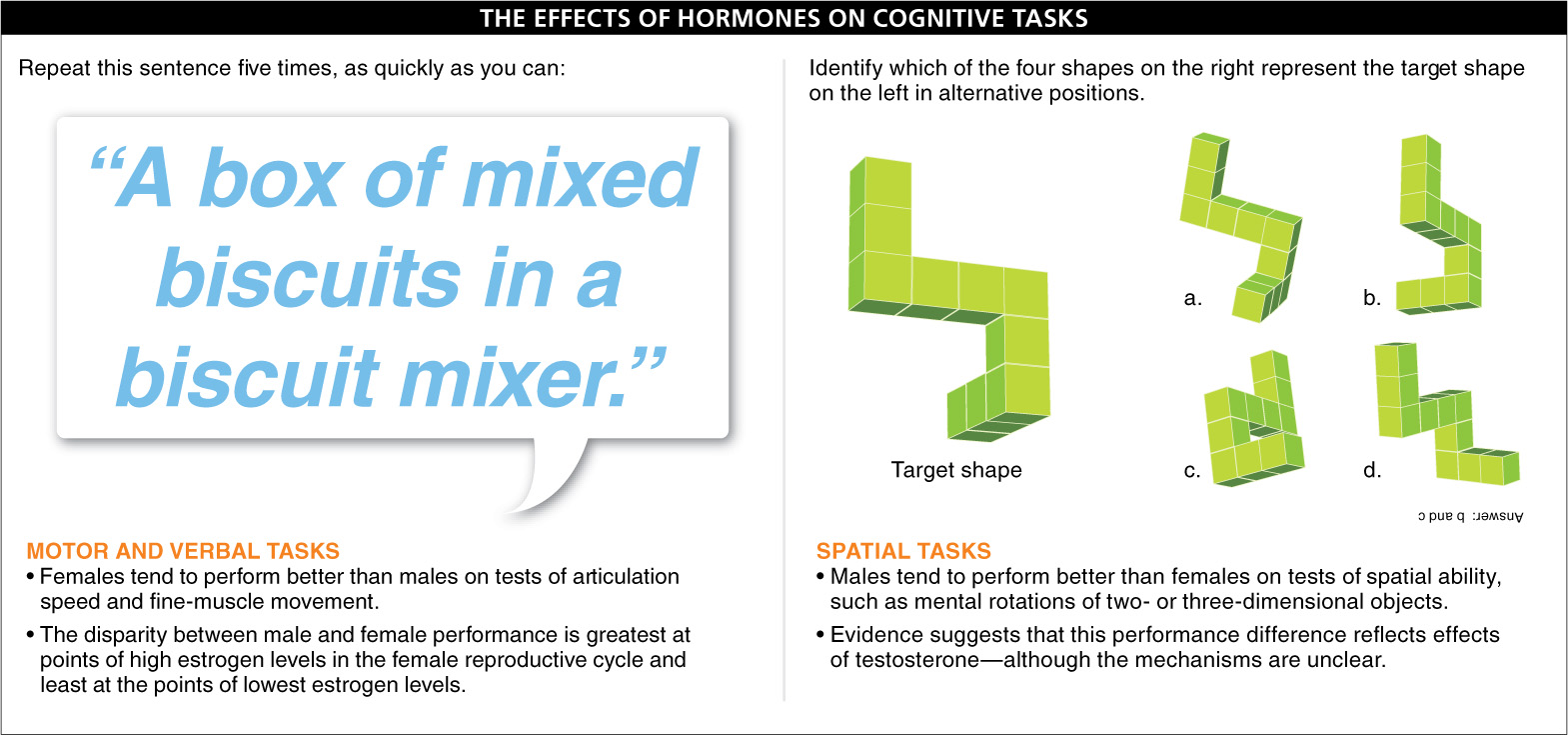Repeat this phrase five times, as quickly as you can: “A box of mixed biscuits in a biscuit mixer.” Researchers found that, at the midpoint in their ovulatory cycle, women in the study group could do this in about 14 seconds. During this time, women’s estrogen levels are at their highest and about 50 times higher than they are in men. During the period just after menstruation, estrogen levels in women are at their lowest, but are still about 3 times higher than in men. Post-
The methods used in this widely reported study have been criticized for several reasons, including (1) the study was not blind, because the researchers knew what phase of their reproductive cycle the participating women were in, and the women knew why they were being tested, and (2) actual measures of estrogen were not taken—
989
Studies on the effects of hormones on cognitive performance have primarily focused on two types of measures, designed to reflect different aspects of cognition: (1) motor and verbal tasks, and (2) spatial tasks (FIGURE 24-22).


- 1. Motor and verbal tasks include tests of articulation speed, such as the tongue twister, or complex wrist and hand movements and fine-
muscle movements, such as those required in surgery and machine repair. - Most tests of hormone effects on motor and non-
verbal tasks involve comparisons of the performances of men and women or of girls and boys on these tasks. There is consistent and significant evidence that females perform better than males and that the disparity between male and female performances is greatest at points of high estrogen levels in the female reproductive cycle and smallest at the points of lowest estrogen levels. - 2. Spatial tasks include tests such as predicting the shapes of boxes when they are unfolded and flat, and mental rotations, in which two drawings of two-
or three- dimensional objects are compared to see whether they represent the same object, either rotated or as a mirror image.
In humans and other animal species, performance on tests of spatial ability is, on average, higher in males than females. A large body of evidence suggests that this performance difference reflects effects of testosterone—
- As men get older and their testosterone levels decrease, so does their performance on tests of spatial ability.
- In older men, testosterone supplementation improves performance on spatial tasks, while administration of chemicals that reduce the production of testosterone (for the treatment of prostate cancer) causes a decrease in spatial abilities.
- Women with one form of a genetic condition (called congenital adrenal hyperplasia) that causes them to have higher than typical levels of circulating testosterone also have increased performance on tests of spatial ability.
As with tests of motor and verbal tasks, it is not clear exactly how—
Beyond tests of motor and verbal tasks and tests of spatial ability, another component of cognitive performance is memory. Numerous studies report a strong role for estrogen in memory, suggesting that estrogen increases the growth and connections of neurons. A recent study in rodents, for example, showed that treatment with a high dose of estrogen improved a maze-
The stress hormone cortisol has also been implicated in memory abilities. Most studies have reported a relationship that, when plotted as a graph, resembles an inverted “U”: up to a point, increased cortisol improves memory, but excess cortisol and other stress hormones consistently reduce performance. (Removing the adrenal glands, which produce most of the body’s cortisol, impairs performance on tests of memory, but abilities are restored when cortisol is supplemented to typical levels.) Optimum memory performance seems to require moderate levels of cortisol and other stress hormones.
990
TAKE-HOME MESSAGE 24.9
A great number of experimental studies demonstrate that cognitive abilities in humans are influenced by hormones, particularly the reproductive hormones estrogen and testosterone, but also the stress hormone cortisol.
Who is likely to perform better on motor and verbal tasks, men or women? What about spatial tasks? Explain why.
Research studies have revealed consistent and significant evidence that females perform better than males on motor and verbal tasks. The disparity between male and female performance is greatest at points of high estrogen levels in the female reproductive cycle and least at the points of lowest estrogen levels. Males tend to perform better on tests of spatial ability. A large body of evidence suggests that this difference in performance reflects the effects of testosterone in males, although the mechanisms aren't exactly clear.